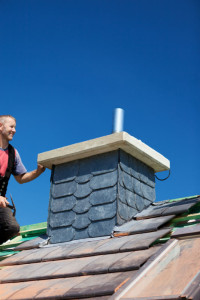One part of the chimney structure that is often ignored is the masonry wash, also known as the chimney crown. While difficult to see from the ground, the chimney crown has an important job to do and helps protect your home as well as your chimney and fireplace system.
What is a chimney crown?
The chimney crown or mortar was is a concrete or masonry slab that covers the top of the chimney and seals around the flue; the top of the flue and the chimney cap are both above the chimney crown. Chimney crowns are typically made of concrete or metal as they are able to best withstand the elements. While some chimney crowns are built using masonry, they may crack or become damaged much faster than other building materials.
The purpose of the chimney crown is to keep moisture out of your home and away from the chimney structure. One of the ways chimney caps do this is by using an edge known as a kerf. The kerf extends two to three inches over the edge of the chimney structure; this lip allows water to flow off of the chimney crown and onto the roof while avoiding the masonry of the chimney structure itself. This design feature can help protect your chimney from water and moisture damage.
What causes chimney crown damage?
The majority of damage to chimney crowns is the result of moisture. Because chimney crowns are flat – or only very gently sloped – water from rain, snow, or ice can pool on top of them. Over time, this can cause holes or cracks to develop in the masonry. The type of building material the chimney crown is made of can make a big difference in protecting against this kind of damage; concrete or metals such as copper or stainless steel are the best building materials for chimney crowns.
Changes in temperature can also impact your chimney crown. Because concrete expands and contracts based on the outside temperature, rapid fluctuations in temperature can cause the concrete to lose the seal around the flue; this can also happen during the winter when the cold masonry is in direct contact with the hot air and gasses in the flue.
How can I tell if my chimney crown is damaged?
One of the most common symptoms of a cracked or damaged chimney crown is a chimney leak. A cracked chimney crown may not cause a leak inside your chimney or fireplace, however; instead, moisture damage may be seen in the attic or on ceilings or walls surrounding the fireplace. Sometimes it may be possible to see serious chimney crown damage from the ground; however, an inspection is often needed in order to correctly diagnose chimney crown damage.
The chimney crown is one of the unsung heroes of your chimney system; don’t let cracks and deterioration to your crown cause other chimney damage. To schedule your chimney inspection or for more information about chimney crown damage, contact New Buck Chimney Services today!

